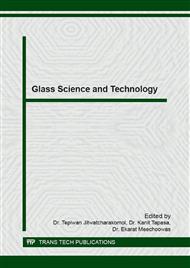[1]
G. Blasse and A. Bril, Investigations on Bi3+-activated phosphors, J. Chem. Phys. 48 (1968) 217-222.
Google Scholar
[2]
N. Kitamura, K. Fukumi, J. Nakamura, T. Hidaka, H. Hashima, Y. Mayumi, J. Nishii, Optical properties of zinc bismuth phosphate glass, Mater. Sci. Eng. B 161 (2009) 91-95.
DOI: 10.1016/j.mseb.2008.12.023
Google Scholar
[3]
I. S. Cho, D. W. Kim, D. H. Kim, S. S. Shin, T. H. Noh, D. W. Kim, K. S. Hong, Electronic band structure, optical properties, and photocatalytic hydrogen production of barium niobium phosphate compounds (BaO-Nb2O5-P2O5), Eur. J. Inorg. Chem. 2011 (2011).
DOI: 10.1002/chin.201131009
Google Scholar
[4]
J. A. Duffy, M. D. Ingram, Behavior of basicity indicator ions in relation to ideal optical basicity of glasses, Phys. Chem. Glasses 16 (1975) 119-123.
Google Scholar
[5]
J. A. Duffy, M. D. Ingram, Optical basicity, in: D.R. Uhlmann, N. D. Kreidl (Eds. ), Optical Properties of Glass, the American Ceramic Society, Westville, 1991, pp.159-184.
Google Scholar
[6]
N. Shcheglova, T. V. Avlas, Glass-formation and some properties of glasses of the system BaO-Nb2O5-P2O5, Fiz. Khim. Stekla 16 (1990) 879-883.
Google Scholar
[7]
B. Elouadi, M. Ouchetto, ElH. Aribib, N. Amraoui, Glass forming regions and dielectric properties of new phosphate glasses, Phase Trans. 13 (1988) 219-232.
DOI: 10.1080/01411598808206828
Google Scholar
[8]
J. Jirak, L. Koudelka, J. Pospisil, P. Mosner, L. Montagne, L. Delevoye, Study of structure and properties of ZnO-Bi2O3-P2O5 glasses, J. Mater. Sci. 42 (2007) 8592-8598.
DOI: 10.1007/s10853-007-1848-7
Google Scholar
[9]
A. Mogus-Milankovic, A. Santic, V. Licina, D. E. Day, Dielectric behavior and impedance spectroscopy of bismuth iron phosphate glasses, J. Non-Cryst. Solids 351 (2005) 3235-3245.
DOI: 10.1016/j.jnoncrysol.2005.08.011
Google Scholar
[10]
L. Baia, R. Stefan, W. Kiefer, J. Popp, S. Simon, Structural investigation of copper doped B2O3-Bi2O3 glasses with high bismuth oxide content, J. Non-Cryst. Solids 303 (2002) 379-386.
DOI: 10.1016/s0022-3093(02)01042-6
Google Scholar
[11]
A.V. Egorysheva, V. I. Burkov, Y. F. Kargin, V. G. Plotnichenko, V. V. Koltashev, Vibrational spectra of crystals of bismuth borates, Crystallography Rep. 50 (2005) 127-136.
DOI: 10.1134/1.1857259
Google Scholar
[12]
A. A. Kaminskii, P. Becker, L. Bohaty, K. Ueda, K. Takaichi, J. Hanuza, M. Maczka, H. J. Eichler, G. M. A. Gad, Monoclinic bismuth triborate BiB3O6 – a new efficient c(2)+c(3)-nonlinear crystal: multiple stimulated Raman scattering and self-sum-frequency lasing effects, Optics Commun. 206 (2002).
DOI: 10.1016/s0030-4018(02)01386-x
Google Scholar
[13]
N. Kitamura, K. Fukumi, J. Nakamura, T. Hidaka, T. Ikeda, H. Hashima, J. Nishii, Optical properties if fluorine-substituted zinc bismuth phosphate glasses, J. Non-Cryst. Solids 357 (2011) 1188-1192.
DOI: 10.1016/j.jnoncrysol.2010.10.029
Google Scholar
[14]
N. Kitamura, K. Fukumi, S. Kohara, K. Ohara, J. Nishii, Structure of low-Tg ZnO-Bi2O3-P2O5 glass by X-ray diffraction, abstract of The 23rd International Congress on Glasses 2013, p.38.
Google Scholar
[15]
T. Cardinal, E. Fargin, G. LeFlem, M. Couzi, L. Canioni, P. Segonds, L. Sarger, A. Ducasse, F. Adamietz, Non linear optical properties of some niobium(V) oxide glasses, Eur. J. Solid State Inorg. Chem. 33 (1996) 597-605.
DOI: 10.1002/chin.199644010
Google Scholar
[16]
A. Flambard, J. J. Videau, L. Delevoye, T. Cardinal, C. Labrugere, C. A. Rivero, M. Couzi, L. Montagne, J. Non-Cryst. Solids 354 (2008) 3540-3547.
DOI: 10.1016/j.jnoncrysol.2008.03.017
Google Scholar
[17]
N. Kitamura, K. Fukumi, J. Nakamura, T. Hidaka, T. Ikeda, H. Hashima, J. Nishii, Low-Tg bismuth phosphate glasses for glass-imprinting and fabrication of 2D sub-wavelength structure, J. Nonlinear Opt. Phys. Mater. 19 (2010) 753-759.
DOI: 10.1142/s0218863510005662
Google Scholar


